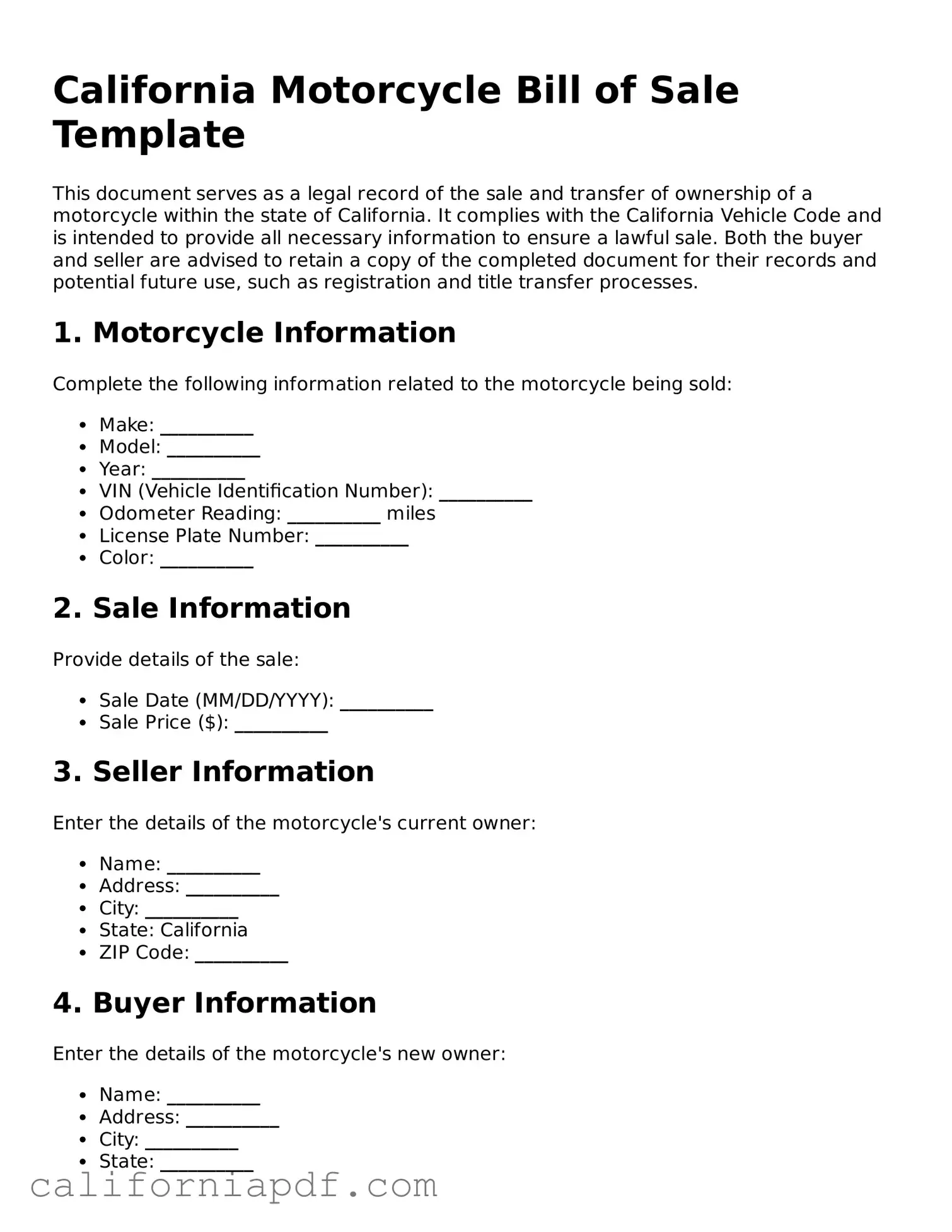The California Motorcycle Bill of Sale form is quite similar to a Vehicle Bill of Sale form used in other transactions involving cars, trucks, and boats. Both documents serve as a recorded agreement of the sale and purchase, detailing the item being sold, the sale price, and the parties involved. These documents are essential for transferring ownership in a legally recognized way, providing proof of the transaction for both buyer and seller.
Another document akin to the California Motorcycle Bill of Sale is the Equipment Bill of Sale. This type of bill of sale is used for the sale of machinery or other professional equipment. Like the motorcycle bill, it outlines the transaction specifics, including a description of the equipment, sale price, and information about the buyer and seller. It's particularly useful for businesses and professionals who need to document the sale of assets for accounting or tax purposes.
The General Bill of Sale is also related closely; it's a more versatile form that can be utilized for various personal property sales, ranging from electronics to furniture. It functions under the same premise: to provide a written record of a sale, including identifying details of the sold item, the sale amount, and the identities of the involved parties. This similarity underscores its fundamental role in confirming the exchange between buyer and seller.
The Firearm Bill of Sale specifically caters to the sale of guns and rifles, making it similar but more specialized compared to the Motorcycle Bill of Sale. Despite their different focuses, both documents safeguard the seller from potential legal liabilities and ensure the buyer legally takes possession. Details such, as serial numbers for firearms, mirror the vehicle identification number (VIN) on vehicle-related sales documents, highlighting the importance of tracing ownership.
A Livestock Bill of Sale is another similar document, primarily used in the sale and purchase of animals like horses, cattle, and other farm animals. Though it differs in the type of property being sold, the principle remains the same as the Motorcycle Bill of Sale, including specifics about the sale transaction, the animal being sold, and the parties' information. This ensures a clear transfer of ownership and provides a legal record.
The Business Bill of Sale is related as it outlines the sale of a business or business assets from one party to another. This document contains detailed information about the business being sold, including assets and liabilities, much like how the Motorcycle Bill of Sale includes specifics about the motorcycle. It’s crucial for the accurate transfer of ownership and the clear delineation of what is being bought and sold.
The Real Estate Bill of Sale differs in terms of the item being sold—real property instead of personal property—but it shares the fundamental purpose of documenting the sale of property. This includes details like the property location, sale price, and buyer and seller information. Although real estate transactions require more formal procedures and registrations, the essence of documenting the transaction is aligned with the Motorcycle Bill of Sale's objectives.
An Aircraft Bill of Sale is also akin to the Motorcycle Bill of Sale, despite the difference in the type of property. Used for the sale of airplanes and other aircraft, it details the transaction, including aircraft specifics, price, and party information. This document is particularly important for registration and legal purposes, similar to the registration requirements for motorcycles and other motor vehicles.
Lastly, the Artwork Bill of Sale can be compared as it documents the sale of art pieces from one individual to another. Though art and motorcycles are vastly different commodities, the need for a legal record of the transaction brings these documents together. Information about the artwork, such as the artist, date of creation, and authenticity, parallels vehicle specifics in a Motorcycle Bill of Sale, underscoring their shared importance in confirming ownership transfer.
